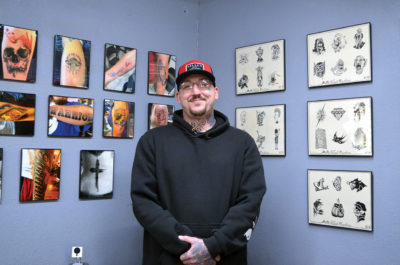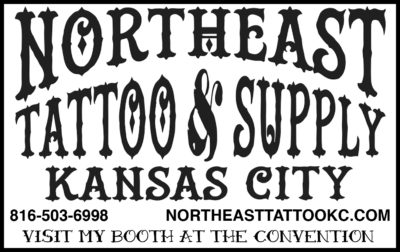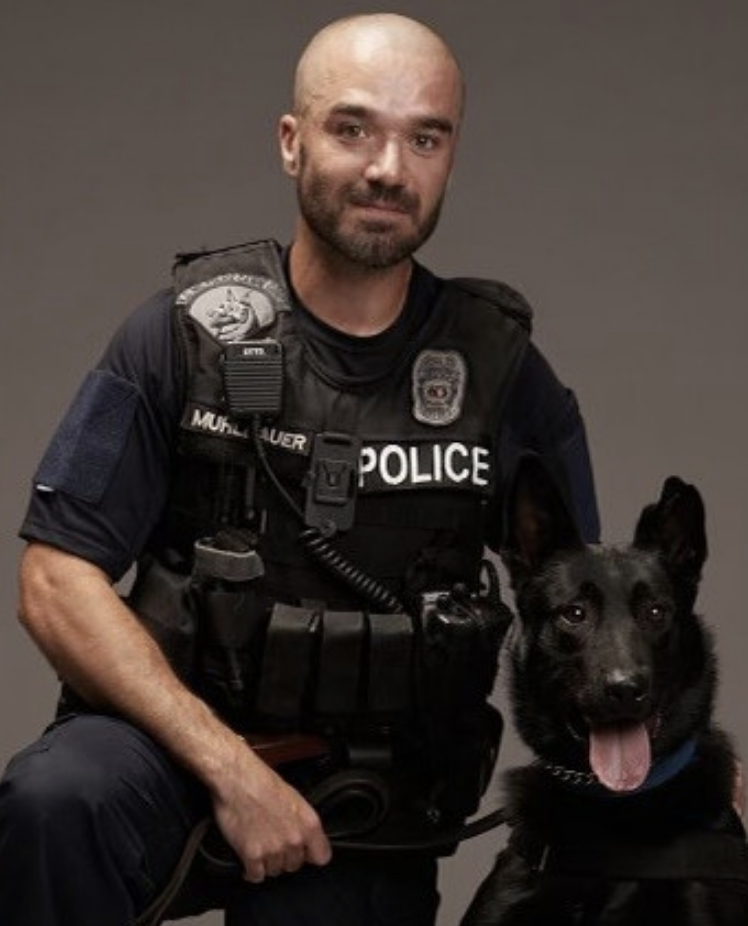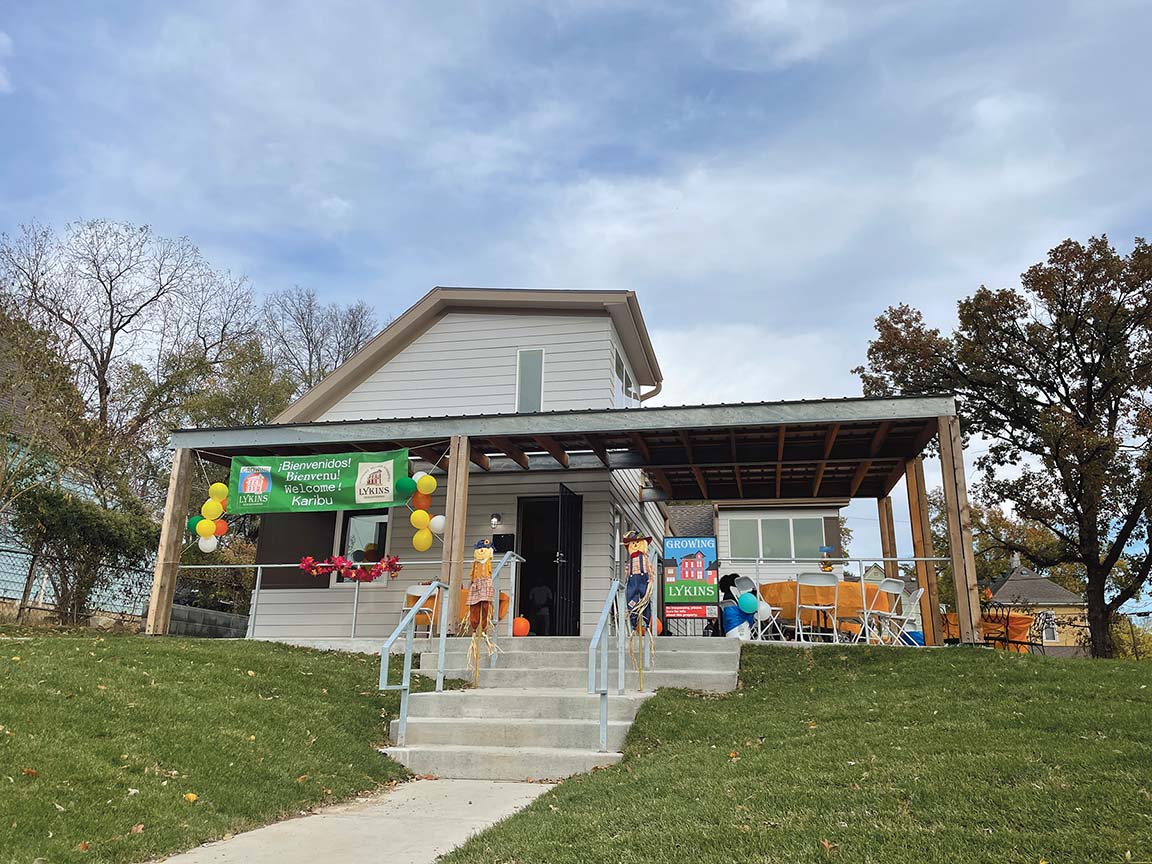
Elizabeth Orosco
Northeast News
Nick Young got his first tattoo at 13 years old: a small cross on his hand that has since been covered up. Now, Young is covered in ink, including a knife on his left temple, a large “X” on the front of his neck with the letters “KTCS”, and a Kansas City Chiefs logo on the right side of his neck.
Young said he has no idea how many he actually has.
Over two decades after that first tattoo, Young owns and operates Northeast Tattoo and Supply in the Historic Northeast as a one-man show. He books clients, does all the tattoo work, sets up, tears down, and sells various tattoo supply items to other licensed artists.
He opened the shop late last year and did his first tattoo a few days before Christmas.
Inside his shop on St. John Avenue, tattoo sketches and customer photos line the walls. Industry supplies, medical equipment, ink, practice skin, and body jewelry sit in a glass case countertop.
A single black tattoo chair sits on the far side of the shop, with a sign above it that reads “Just Five More Minutes.”
Young grew up in Kansas City, Kansas, doodling and drawing in school and, as he puts it, “getting yelled at for not paying attention.”
Turns out, his artistic interest and talent would pave his long-term career path.
Young’s interest in the tattoo industry grew over time, evolving from drawing sketches on paper to etching permanent images on skin.
The two mediums, he said, are completely opposite experiences.
“It’s a totally different world. Drawing on paper and permanently inking somebody’s body is night and day. On paper, you’ve got an eraser. I can erase stuff like it never happened. But this tattoo is forever. Every second that you’re doing this tattoo, you should be thinking about that.”
For him, tattooing is a mentally and emotionally draining job. With every line, every mark, Young said he is constantly drawing upon every part of himself to create the best piece of art he can for his customers.
Tattoos, he said, have a permanent impact.
“I’m always thinking that this tattoo is going to have either a positive or negative impact on this person’s life— one wrong move can destroy it or make it a masterpiece. That is something very hard to have hanging over your head everyday, but I feel like you should always be aware of what you’re doing and what is going to happen down the line based on how this tattoo comes out. A good tattoo can make you feel on top of the world and like you’re a whole new person.”
The path to becoming a licensed tattoo artist is strenuous, but worth it, Young emphasizes.
In the state of Missouri, to earn a tattoo license, you must be CPR certified, take bloodborne pathogen courses, and complete 50 supervised procedures that accumulate to 300 or more hours under a licensed mentor.
Young said the bullet points that aren’t included in the requirements are learning to set up, tear down, clean and sanitize every workstation, make paper towel runs at any given moment, and learn the daily ins and outs of shop operations.
“It’s humbling, but you always need to be willing to learn and evolve and change and keep the knowledge coming in,” he said.
Young’s first tattoo he ever performed was on himself. Etched into his upper thigh. While sitting at his kitchen table. Using a tattoo kit he bought off the internet.
It’s a tattoo of his name and— as he said grinning— “it turned out f***ing awesome.”
While his first tattoo procedure decades ago was lax at best, Young said he takes extreme precaution with every customer that walks in his door.
The first thing he looks for is any sign of inebriation or the inability to use proper judgment. If there is any indication that the customer isn’t sober, “number one, the tattoo isn’t happening,” he said.
If the customer is in the right state of mind, he checks for an I.D. and makes sure they are over 18. If everything checks out from there, he can begin setting up.
Young said he uses universal precautions in cross-contamination prevention to ensure every inch of surface that he will be touching or skin will be exposed to is covered in barrier film. This includes his light with an adjustable neck, the tattoo chair, work surface, and any area that blood could touch.
Any needles that penetrate the skin are one-time use only, and are tossed into a sharps bucket immediately after use.
Once the tattoo is complete, the customer is bandaged and wrapped, given after-care instructions, offered an extensive selection of after-care products, and given the website information which redirects them to the instructions. Once the customer is out the door, Young said he breaks everything down, unwraps everything, and sprays every surface with a hospital-grade disinfectant.
He explained the severity of this step, stressing the reality of how easily deadly diseases could be spread if this step isn’t executed properly.
If a customer is carrying a deadly disease, and their blood is not wiped properly before the next customer sits in the same chair, the needle penetration spot or any open wound that touches the poorly-wiped blood, is now infected with that disease.
Young said the stigma surrounding tattoos seems to be fading as the years progress.
“Honestly, I feel like there’s less and less stigma. It’s less taboo, I’m getting a lot more suburban, middle-aged moms coming in and getting half-sleeves. It’s 2019. If you have a tattoo nowadays, it does not mean that you’re in a gang.”
While he never knows what type of request is going to walk through his door, Young said he frequently gets people who are getting a tattoo for the first time, and he sees it as part of his job to make them feel at ease.
“I just talk to them. I ask what the meaning is behind the tattoo or ask about their occupation. You have to have a relationship with that person.”
He pauses here to paint a visual of a gruff, menacing-looking biker guy who doesn’t say a word while he is tattooing.
“First of all, I’ve been tattooed by that guy. You just say thanks, tip him, and get out of there. You’d never tell him you don’t like it.”
This, however, is not the vibe Young said he ever wants to give others.
“I want to be open with people so they can communicate with me effectively. You have to have open communication. If they want me to change something, I say ‘no problem,’ and continue on.”
While Young said his journey to becoming the tattoo artist he is today was full of rough, rocky patches, he offers sage advice to aspiring tattoo artists:
“Anybody out there considering a tattoo career, please get into a tattoo shop as soon as you can. I don’t care if you have to download the bus schedule online, there are too many excuses being made as to why these guys aren’t in a tattoo shop yet. If I can do it, anyone else can. Stop tattooing from home. Go work in a shop so you can at least know that you’re not hurting people, and feel free to come by my shop so I can point you in the right direction to get the education that you need.”



















